Hyundai Accent 2013 Owner's Manual
Manufacturer: HYUNDAI, Model Year: 2013, Model line: Accent, Model: Hyundai Accent 2013Pages: 402, PDF Size: 8.49 MB
Page 391 of 402
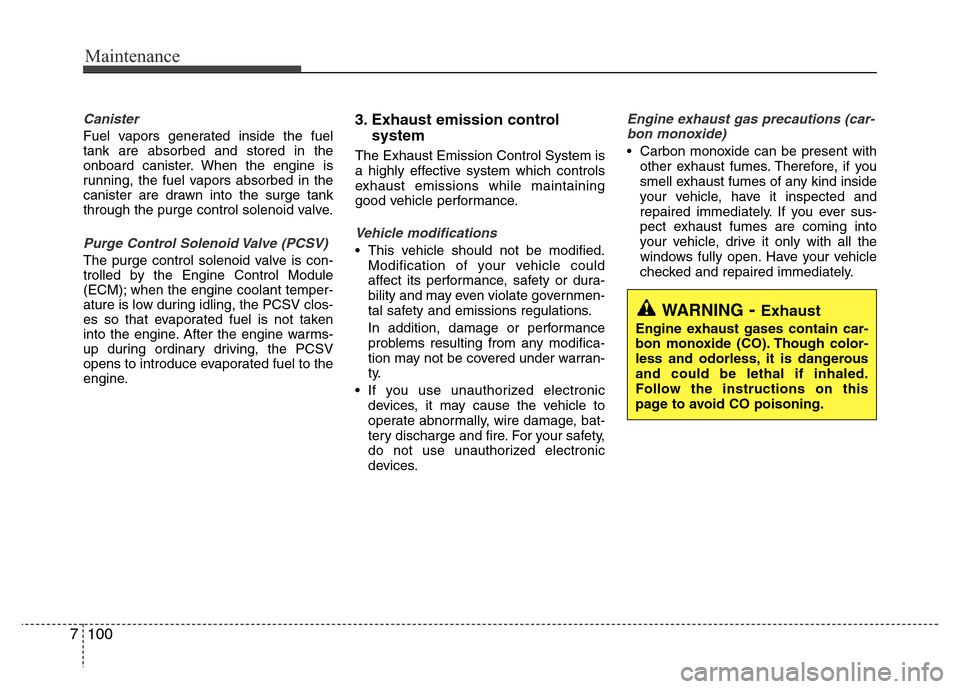
Maintenance
100 7
Canister
Fuel vapors generated inside the fuel
tank are absorbed and stored in the
onboard canister. When the engine is
running, the fuel vapors absorbed in the
canister are drawn into the surge tank
through the purge control solenoid valve.
Purge Control Solenoid Valve (PCSV)
The purge control solenoid valve is con-
trolled by the Engine Control Module
(ECM); when the engine coolant temper-
ature is low during idling, the PCSV clos-
es so that evaporated fuel is not taken
into the engine. After the engine warms-
up during ordinary driving, the PCSV
opens to introduce evaporated fuel to the
engine.
3. Exhaust emission control
system
The Exhaust Emission Control System is
a highly effective system which controls
exhaust emissions while maintaining
good vehicle performance.
Vehicle modifications
• This vehicle should not be modified.
Modification of your vehicle could
affect its performance, safety or dura-
bility and may even violate governmen-
tal safety and emissions regulations.
In addition, damage or performance
problems resulting from any modifica-
tion may not be covered under warran-
ty.
• If you use unauthorized electronic
devices, it may cause the vehicle to
operate abnormally, wire damage, bat-
tery discharge and fire. For your safety,
do not use unauthorized electronic
devices.
Engine exhaust gas precautions (car-
bon monoxide)
• Carbon monoxide can be present with
other exhaust fumes. Therefore, if you
smell exhaust fumes of any kind inside
your vehicle, have it inspected and
repaired immediately. If you ever sus-
pect exhaust fumes are coming into
your vehicle, drive it only with all the
windows fully open. Have your vehicle
checked and repaired immediately.
WARNING- Exhaust
Engine exhaust gases contain car-
bon monoxide (CO). Though color-
less and odorless, it is dangerous
and could be lethal if inhaled.
Follow the instructions on this
page to avoid CO poisoning.
Page 392 of 402
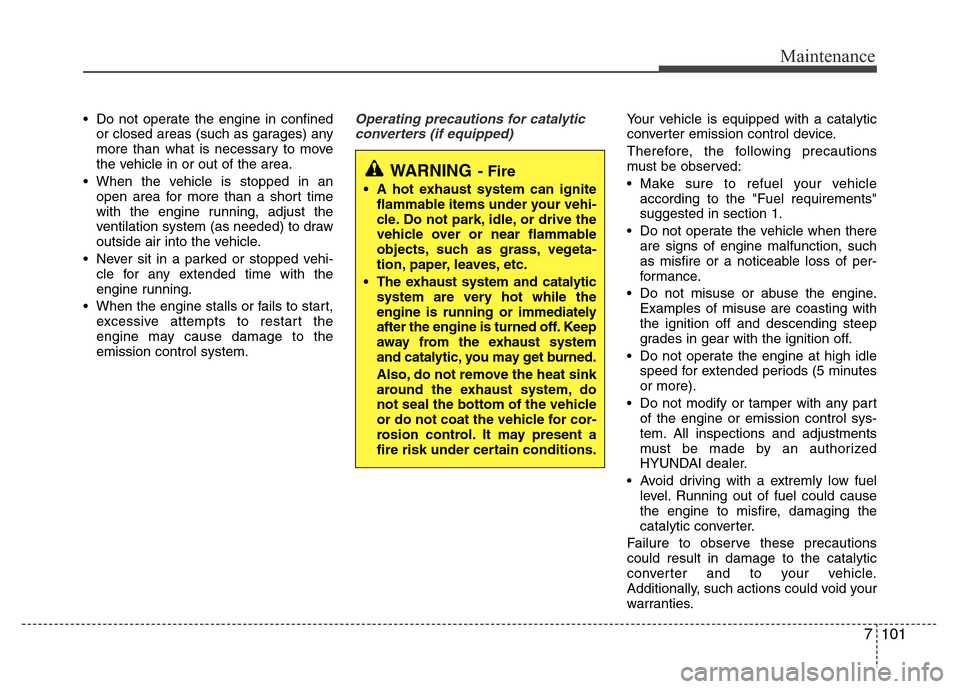
7101
Maintenance
• Do not operate the engine in confined
or closed areas (such as garages) any
more than what is necessary to move
the vehicle in or out of the area.
• When the vehicle is stopped in an
open area for more than a short time
with the engine running, adjust the
ventilation system (as needed) to draw
outside air into the vehicle.
• Never sit in a parked or stopped vehi-
cle for any extended time with the
engine running.
• When the engine stalls or fails to start,
excessive attempts to restart the
engine may cause damage to the
emission control system.Operating precautions for catalytic
converters (if equipped)Your vehicle is equipped with a catalytic
converter emission control device.
Therefore, the following precautions
must be observed:
• Make sure to refuel your vehicle
according to the "Fuel requirements"
suggested in section 1.
• Do not operate the vehicle when there
are signs of engine malfunction, such
as misfire or a noticeable loss of per-
formance.
• Do not misuse or abuse the engine.
Examples of misuse are coasting with
the ignition off and descending steep
grades in gear with the ignition off.
• Do not operate the engine at high idle
speed for extended periods (5 minutes
or more).
• Do not modify or tamper with any part
of the engine or emission control sys-
tem. All inspections and adjustments
must be made by an authorized
HYUNDAI dealer.
• Avoid driving with a extremly low fuel
level. Running out of fuel could cause
the engine to misfire, damaging the
catalytic converter.
Failure to observe these precautions
could result in damage to the catalytic
converter and to your vehicle.
Additionally, such actions could void your
warranties.
WARNING- Fire
• A hot exhaust system can ignite
flammable items under your vehi-
cle. Do not park, idle, or drive the
vehicle over or near flammable
objects, such as grass, vegeta-
tion, paper, leaves, etc.
• The exhaust system and catalytic
system are very hot while the
engine is running or immediately
after the engine is turned off. Keep
away from the exhaust system
and catalytic, you may get burned.
Also, do not remove the heat sink
around the exhaust system, do
not seal the bottom of the vehicle
or do not coat the vehicle for cor-
rosion control. It may present a
fire risk under certain conditions.
Page 393 of 402
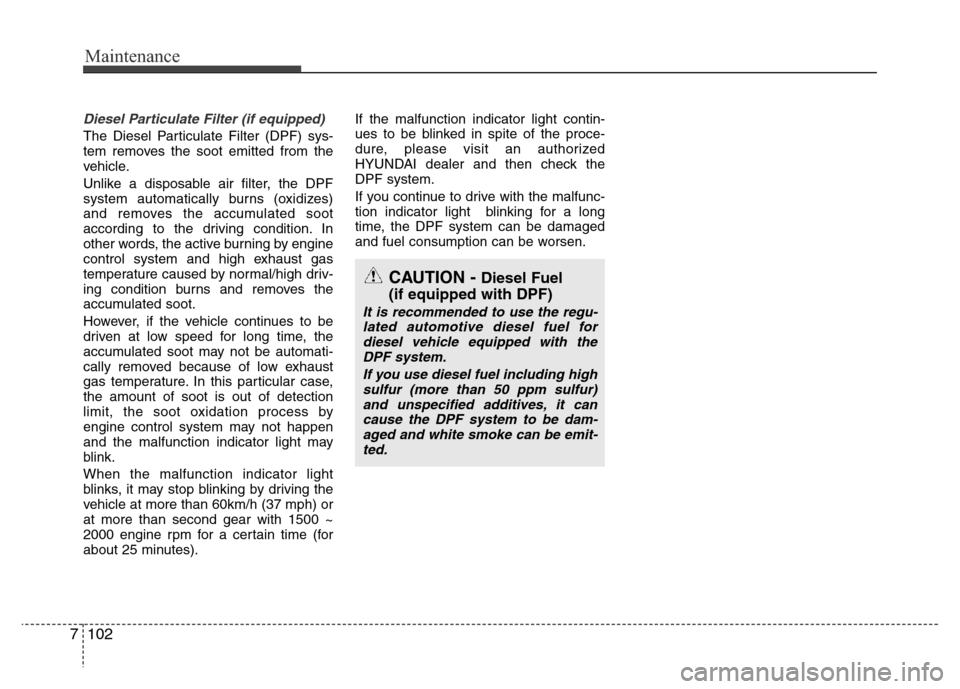
Maintenance
102 7
Diesel Particulate Filter (if equipped)
The Diesel Particulate Filter (DPF) sys-
tem removes the soot emitted from the
vehicle.
Unlike a disposable air filter, the DPF
system automatically burns (oxidizes)
and removes the accumulated soot
according to the driving condition. In
other words, the active burning by engine
control system and high exhaust gas
temperature caused by normal/high driv-
ing condition burns and removes the
accumulated soot.
However, if the vehicle continues to be
driven at low speed for long time, the
accumulated soot may not be automati-
cally removed because of low exhaust
gas temperature. In this particular case,
the amount of soot is out of detection
limit, the soot oxidation process by
engine control system may not happen
and the malfunction indicator light may
blink.
When the malfunction indicator light
blinks, it may stop blinking by driving the
vehicle at more than 60km/h (37 mph) or
at more than second gear with 1500 ~
2000 engine rpm for a certain time (for
about 25 minutes).If the malfunction indicator light contin-
ues to be blinked in spite of the proce-
dure, please visit an authorized
HYUNDAI dealer and then check the
DPF system.
If you continue to drive with the malfunc-
tion indicator light blinking for a long
time, the DPF system can be damaged
and fuel consumption can be worsen.
CAUTION - Diesel Fuel
(if equipped with DPF)
It is recommended to use the regu-
lated automotive diesel fuel for
diesel vehicle equipped with the
DPF system.
If you use diesel fuel including high
sulfur (more than 50 ppm sulfur)
and unspecified additives, it can
cause the DPF system to be dam-
aged and white smoke can be emit-
ted.
Page 394 of 402
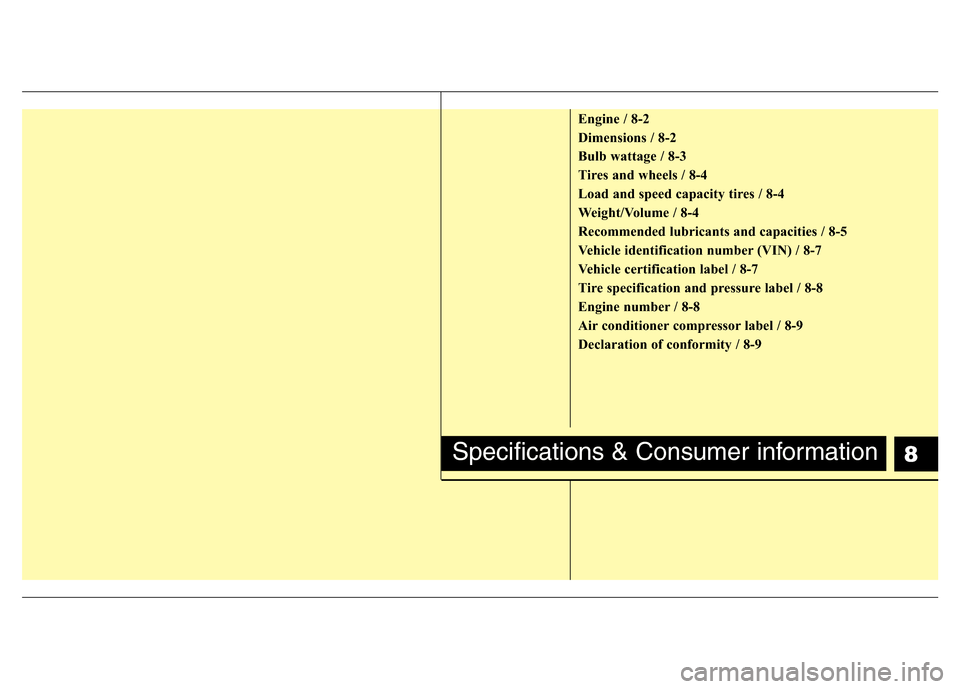
8
Engine / 8-2
Dimensions / 8-2
Bulb wattage / 8-3
Tires and wheels / 8-4
Load and speed capacity tires / 8-4
Weight/Volume / 8-4
Recommended lubricants and capacities / 8-5
Vehicle identification number (VIN) / 8-7
Vehicle certification label / 8-7
Tire specification and pressure label / 8-8
Engine number / 8-8
Air conditioner compressor label / 8-9
Declaration of conformity / 8-9
Specifications & Consumer information
Page 395 of 402
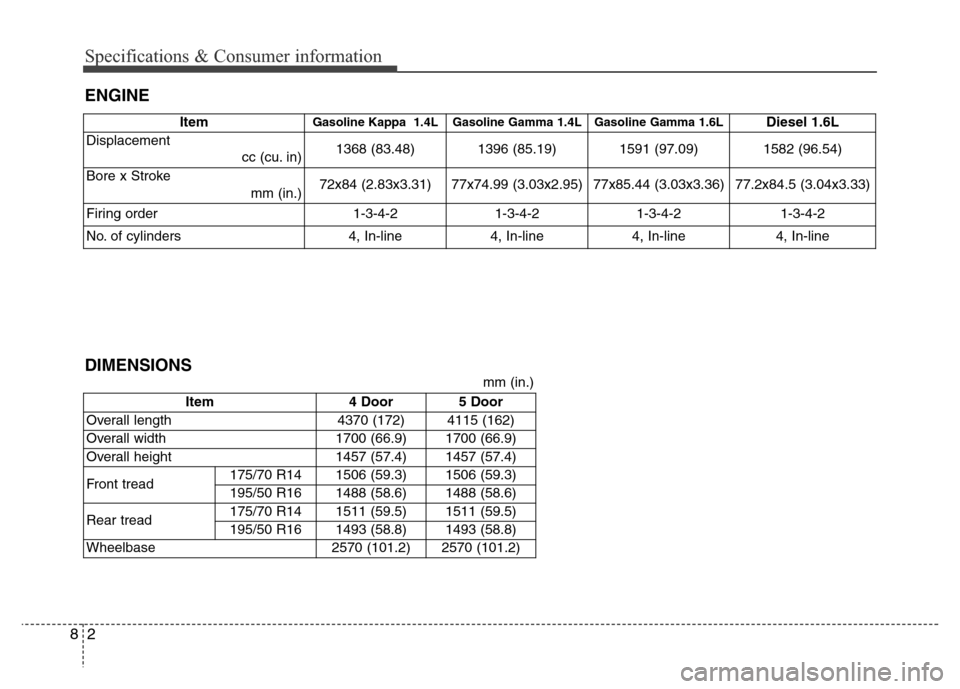
Specifications & Consumer information
2 8
ENGINE
Item 4 Door5 Door
Overall length 4370 (172)
4115 (162)
Overall width 1700 (66.9)
1700 (66.9)
Overall height 1457 (57.4)
1457 (57.4)
Front tread175/70 R14 1506 (59.3)
1506 (59.3)
195/50 R16 1488 (58.6)
1488 (58.6)
Rear tread175/70 R14 1511 (59.5)
1511 (59.5)
195/50 R16 1493 (58.8)
1493 (58.8)
Wheelbase 2570 (101.2)
2570 (101.2)
ItemGasoline Kappa 1.4L Gasoline Gamma 1.4L Gasoline Gamma 1.6LDiesel 1.6L
Displacement
cc (cu. in)
1368 (83.48) 1396 (85.19) 1591 (97.09) 1582 (96.54)
Bore x Stroke
mm (in.)
72x84 (2.83x3.31) 77x74.99 (3.03x2.95) 77x85.44 (3.03x3.36) 77.2x84.5 (3.04x3.33)
Firing order
1-3-4-2 1-3-4-2 1-3-4-2 1-3-4-2
No. of cylinders
4, In-line 4, In-line 4, In-line 4, In-line
DIMENSIONS
mm (in.)
Page 396 of 402
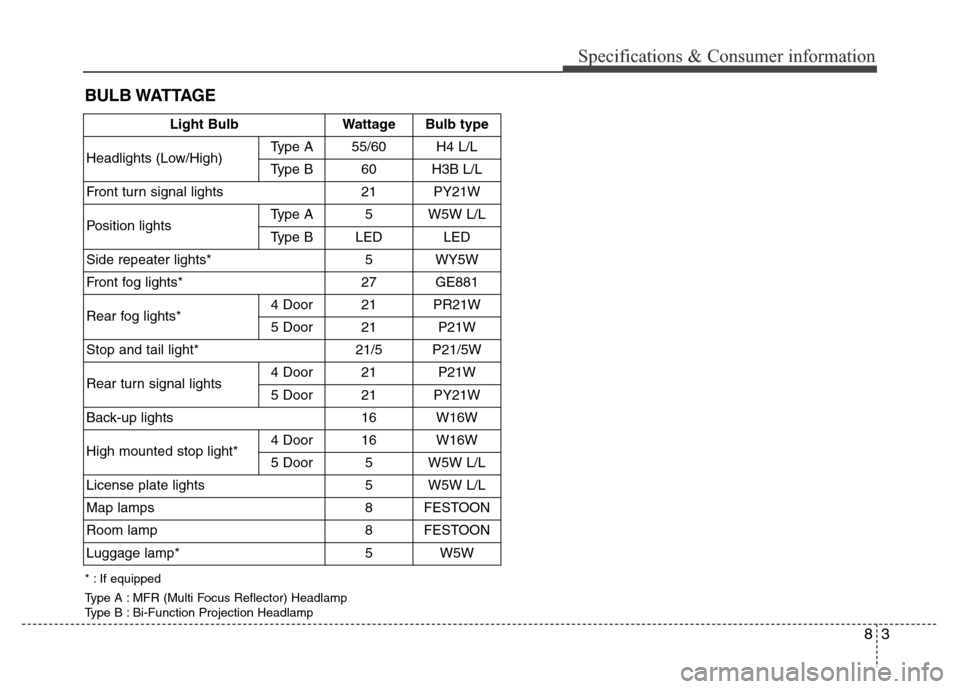
83
Specifications & Consumer information
BULB WATTAGE
Light BulbWattageBulb type
Headlights (Low/High)Type A55/60H4 L/L
Type B60H3B L/L
Front turn signal lights21PY21W
Position lightsType A5W5W L/L
Type BLEDLED
Side repeater lights* 5WY5W
Front fog lights*27GE881
Rear fog lights* 4 Door21PR21W
5 Door21P21W
Stop and tail light* 21/5P21/5W
Rear turn signal lights 4 Door21P21W
5 Door21PY21W
Back-up lights16W16W
High mounted stop light*4 Door16W16W
5 Door5W5W L/L
License plate lights5W5W L/L
Map lamps8FESTOON
Room lamp8FESTOON
Luggage lamp*5W5W
* : If equipped
Type A : MFR (Multi Focus Reflector) Headlamp
Type B : Bi-Function Projection Headlamp
Page 397 of 402
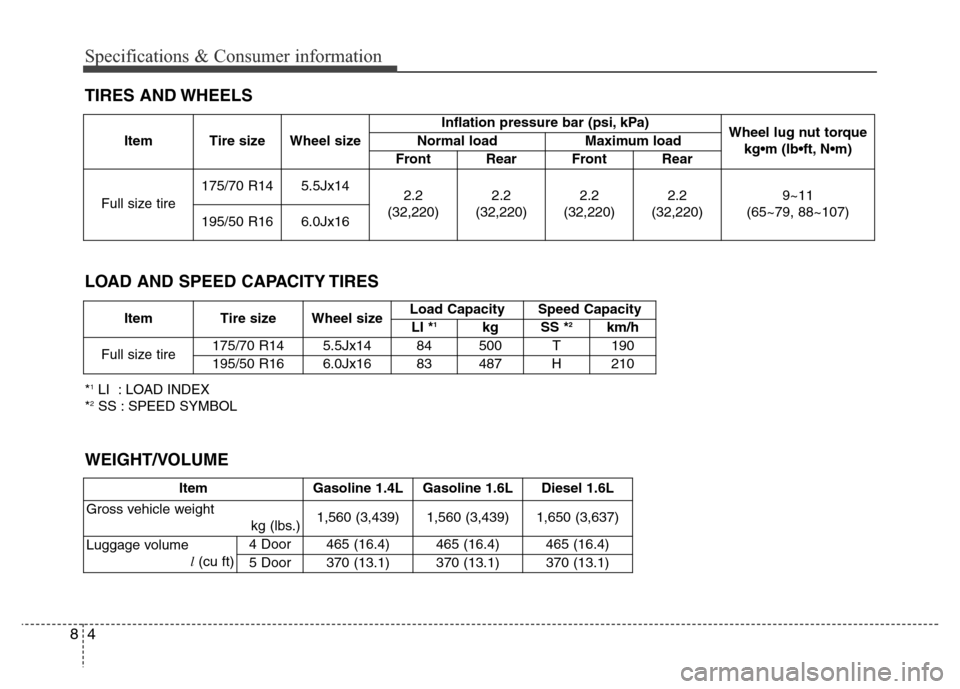
Specifications & Consumer information
4 8
TIRES AND WHEELS
Item Tire size Wheel sizeInflation pressure bar (psi, kPa)
Wheel lug nut torque
kg•m (lb•ft, N•m) Normal load Maximum load
Front Rear Front Rear
Full size tire175/70 R14 5.5Jx14
2.2
(32,220)2.2
(32,220)2.2
(32,220)2.2
(32,220)9~11
(65~79, 88~107)
195/50 R16 6.0Jx16
WEIGHT/VOLUME
Item Gasoline 1.4L Gasoline 1.6L Diesel 1.6L
Gross vehicle weight
kg (lbs.)1,560 (3,439) 1,560 (3,439) 1,650 (3,637)
Luggage volume
l(cu ft)4 Door 465 (16.4) 465 (16.4) 465 (16.4)
5 Door370 (13.1)370 (13.1)370 (13.1)
*1LI : LOAD INDEX
*2SS : SPEED SYMBOLItem Tire size Wheel sizeLoad Capacity Speed Capacity
LI *
1kg SS *2km/h
Full size tire175/70 R14 5.5Jx14 84 500 T 190
195/50 R16 6.0Jx16 83 487 H 210
LOAD AND SPEED CAPACITY TIRES
Page 398 of 402
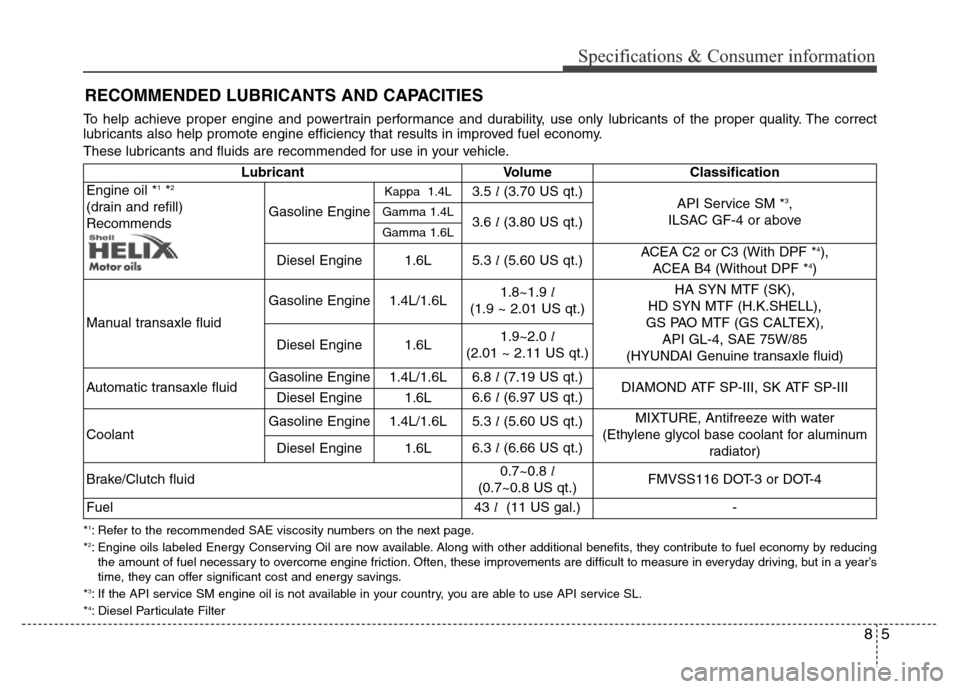
85
Specifications & Consumer information
RECOMMENDED LUBRICANTS AND CAPACITIES
Lubricant Volume Classification
Engine oil *1*2
(drain and refill)
RecommendsGasoline Engine
Kappa 1.4L3.5 l(3.70 US qt.)
API Service SM *3,
ILSAC GF-4 or aboveGamma 1.4L3.6 l(3.80 US qt.)Gamma 1.6L
Diesel Engine1.6L5.3 l(5.60 US qt.)ACEA C2 or C3 (With DPF *4),
ACEA B4 (Without DPF *4)
Manual transaxle fluid
Gasoline Engine1.4L/1.6L1.8~1.9 l
(1.9 ~ 2.01 US qt.)HA SYN MTF (SK),
HD SYN MTF (H.K.SHELL),
GS PAO MTF (GS CALTEX),
API GL-4, SAE 75W/85
(HYUNDAI Genuine transaxle fluid)
Diesel Engine1.6L1.9~2.0 l
(2.01 ~ 2.11 US qt.)
Automatic transaxle fluidGasoline Engine 1.4L/1.6L6.8 l(7.19 US qt.)
DIAMOND ATF SP-III, SK ATF SP-III
Diesel Engine1.6L6.6 l(6.97 US qt.)
Coolant Gasoline Engine 1.4L/1.6L5.3 l(5.60 US qt.)MIXTURE, Antifreeze with water
(Ethylene glycol base coolant for aluminum
radiator)
Diesel Engine1.6L6.3 l(6.66 US qt.)
Brake/Clutch fluid0.7~0.8 l
(0.7~0.8 US qt.)FMVSS116 DOT-3 or DOT-4
Fuel43 l(11 US gal.)-
To help achieve proper engine and powertrain performance and durability, use only lubricants of the proper quality. The correct
lubricants also help promote engine efficiency that results in improved fuel economy.
These lubricants and fluids are recommended for use in your vehicle.
*1: Refer to the recommended SAE viscosity numbers on the next page.
*2: Engine oils labeled Energy Conserving Oil are now available. Along with other additional benefits, they contribute to fuel economy by reducing
the amount of fuel necessary to overcome engine friction. Often, these improvements are difficult to measure in everyday driving, but in a year’s
time, they can offer significant cost and energy savings.
*
3: If the API service SM engine oil is not available in your country, you are able to use API service SL.
*4: Diesel Particulate Filter
Page 399 of 402
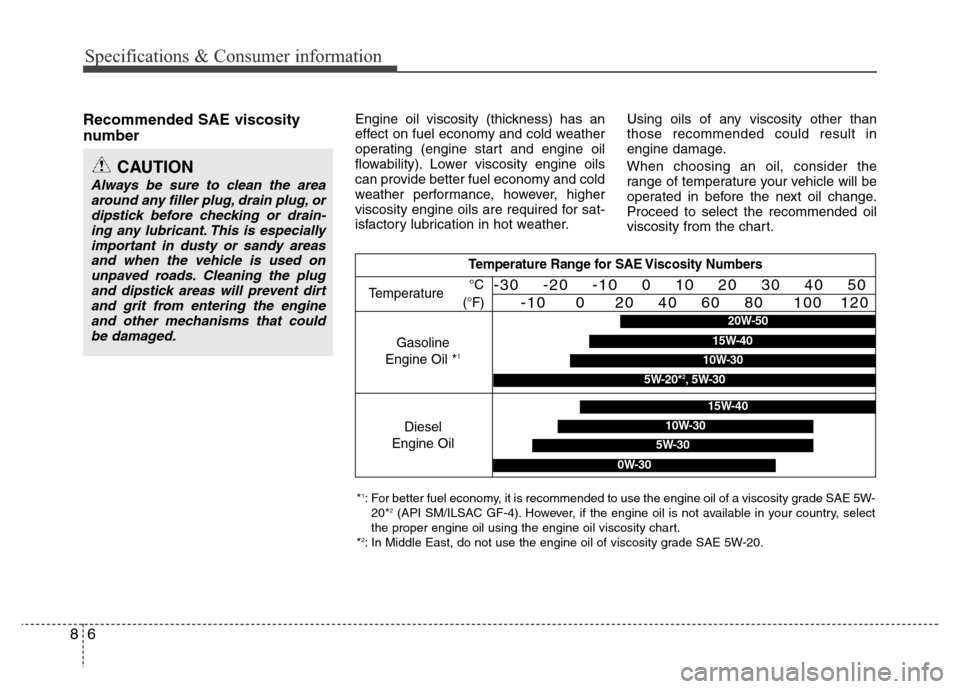
Specifications & Consumer information
6 8
Recommended SAE viscosity
numberEngine oil viscosity (thickness) has an
effect on fuel economy and cold weather
operating (engine start and engine oil
flowability). Lower viscosity engine oils
can provide better fuel economy and cold
weather performance, however, higher
viscosity engine oils are required for sat-
isfactory lubrication in hot weather.Using oils of any viscosity other than
those recommended could result in
engine damage.
When choosing an oil, consider the
range of temperature your vehicle will be
operated in before the next oil change.
Proceed to select the recommended oil
viscosity from the chart.
CAUTION
Always be sure to clean the area
around any filler plug, drain plug, or
dipstick before checking or drain-
ing any lubricant. This is especially
important in dusty or sandy areas
and when the vehicle is used on
unpaved roads. Cleaning the plug
and dipstick areas will prevent dirt
and grit from entering the engine
and other mechanisms that could
be damaged.
Temperature Range for SAE Viscosity Numbers
Temperature°C
(°F)-30 -20 -10 0 10 20 30 40 50
-10 0 20 40 60 80 100 120
Diesel
Engine Oil
5W-30
15W-40
10W-30
0W-30
*1: For better fuel economy, it is recommended to use the engine oil of a viscosity grade SAE 5W-
20*2(API SM/ILSAC GF-4). However, if the engine oil is not available in your country, select
the proper engine oil using the engine oil viscosity chart.
*
2: In Middle East, do not use the engine oil of viscosity grade SAE 5W-20.
Gasoline
Engine Oil *1
20W-50
10W-30
15W-40
5W-20*2, 5W-30
Page 400 of 402
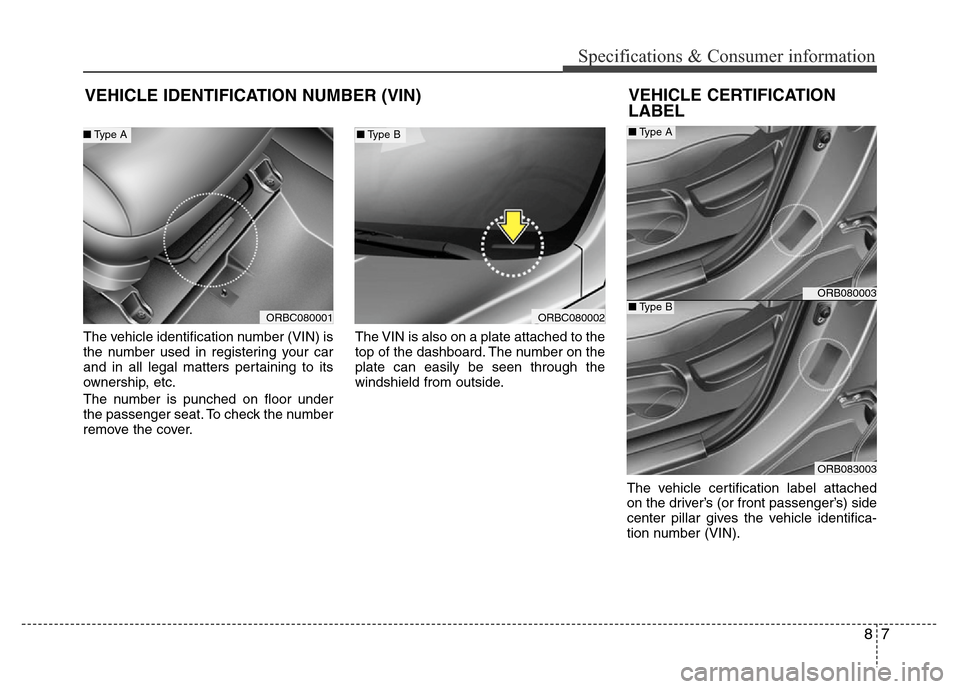
87
Specifications & Consumer information
VEHICLE IDENTIFICATION NUMBER (VIN)
The vehicle identification number (VIN) is
the number used in registering your car
and in all legal matters pertaining to its
ownership, etc.
The number is punched on floor under
the passenger seat. To check the number
remove the cover.The VIN is also on a plate attached to the
top of the dashboard. The number on the
plate can easily be seen through the
windshield from outside.
The vehicle certification label attached
on the driver’s (or front passenger’s) side
center pillar gives the vehicle identifica-
tion number (VIN).
VEHICLE CERTIFICATION
LABEL
ORBC080001
■Type A
ORBC080002
■Type B
ORB080003
ORB083003
■Type A
■Type B